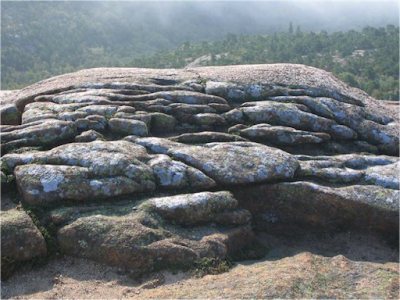An Accidental Mint Garden
We’ve got mint in our yard. It’s just growing there, on its own. I found some at the edge of the woods, and some in the low part of the yard, just growing on the lawn. I knew it was mint partially from the square stem, the shape of the leaves and the way they surround the stem in an opposite pattern, but mostly from the smell. Break a leaf you suspect might be mint, and smell it. It’s unmistakable. In fact, one of the best parts about mint in the yard, is that the whole yard smells like mint when I mow the lawn.
Tristram was quite excited when we discovered the mint. We had mint at our old house, and he loved to pick it and chew the leaves right there in the yard. I love mint also, but chewing the leaves is a bit too strong for me. I prefer my mint in desserts, preferably with chocolate.
| Mint plants at the edge of the woods © dmwoodman 2016 |
The lower part of our yard was where I decided to dig the garden, since it got abundant sun and was moist from the drainage from the rest of the yard. I dug up the sod, tilled the soil, and we planted our seeds. As the seeds sprouted, so did the mint, even though there was no evidence of mint roots in the soil when I tilled it. So how did it get back into the garden?
| Mint growing up amongst the corn © dmwoodman 2016 |
| Mint in between the pumpkins and cucumbers © dmwoodman 2016 |
| Another mint plant hiding in the pumpkin patch © dmwoodman 2016 |
All living things reproduce - make more of themselves. Reproduction happens in one of two basic ways - sexual or asexual. Sexual reproduction happens when two organisms of the same species combine some of their DNA to make new combinations of genes. Animals, as a group, tend to reproduce sexually, many exclusively so.
Reproducing only sexually, though, is rather the exception than the rule. Many organisms, from bacteria to fungi to plants, can reproduce both sexually and asexually. Asexual reproduction involves making a new individual without the use of sex organs or recombining DNA. Except for possible mistakes in copying the DNA, the new individual is essentially a clone of the original. Animal cells reproduce this way all the time - the process of mitosis or cell division - but most animals do not reproduce their whole bodies asexually to make a new organism.
Many plants, however, are particularly good at asexual reproduction*. Jade plants (Crassula ovata), for example, reproduce primarily asexually. Although they can make flowers, they usually spread through a form of asexual reproduction called vegetative reproduction, or propagation. When leaves or branches fall off the plant, they simply form roots and grow and voila! More jade plants. This ease of propagation, and the fact that jade plants are succulents that hold water in their leaves, make them ideal houseplants for friends with brown thumbs. I gave one to a teacher who has a terrible memory for watering plants, and was stuck with a classroom with no windows. It’s doing fine. In fact, I leave my own jade plants in my classroom all summer, giving them a good soak in June when I lock the door on the last day, and then watering them again in August.
| Classroom jade plants © dmwoodman 2016 |
And when they get too tall, I simply grab the scissors, cut off the top 4-5 inches of plant, stick them in a new pot (not usually a pot, actually, any old cup will do), and give them away.
| A jade plant cutting © dmwoodman 2016 |
Milfoil reproduces this way also. Just one stem, or a few leaves, may be enough to start a whole new milfoil plant. That’s why it’s so important that people clean their boats when they move from lake to lake. Only a small amount of milfoil stuck in the motor or on the boat trailer may be enough to establish milfoil in a body of water, and it’s virtually impossible to eradicate. Then there goes the fishing. The whole lake gets clogged with milfoil.
So jade plants and milfoil regrow from bits of leaves and stems, but many other plants reproduce by sending out their roots and popping up a new stem. These reproductive roots are called rhizomes. Other plants send out runners - shoots that look like above-ground roots but are really a special kind of horizontal stem. Mint does both. Therefore, mint in your lawn can start growing in the garden nearby. Mint can also regrow from roots that are buried deep in the soil. We’ve now got so much mint in the garden that I had to pull out half of it so it wouldn’t take over the area reserved for Tristram’s precious beans.
So what to do with all the mint? You can freeze it, dry it, or use it fresh. Me, I’m using most of it to make homemade mint extract.
*Many species of invasive plants, such as japanese knotweed and purple loosestrife, reproduce both sexually and asexually with ease. This ability to produce thousands, if not millions of offspring, is part of why these plants are so difficult to get rid of once they become established.


